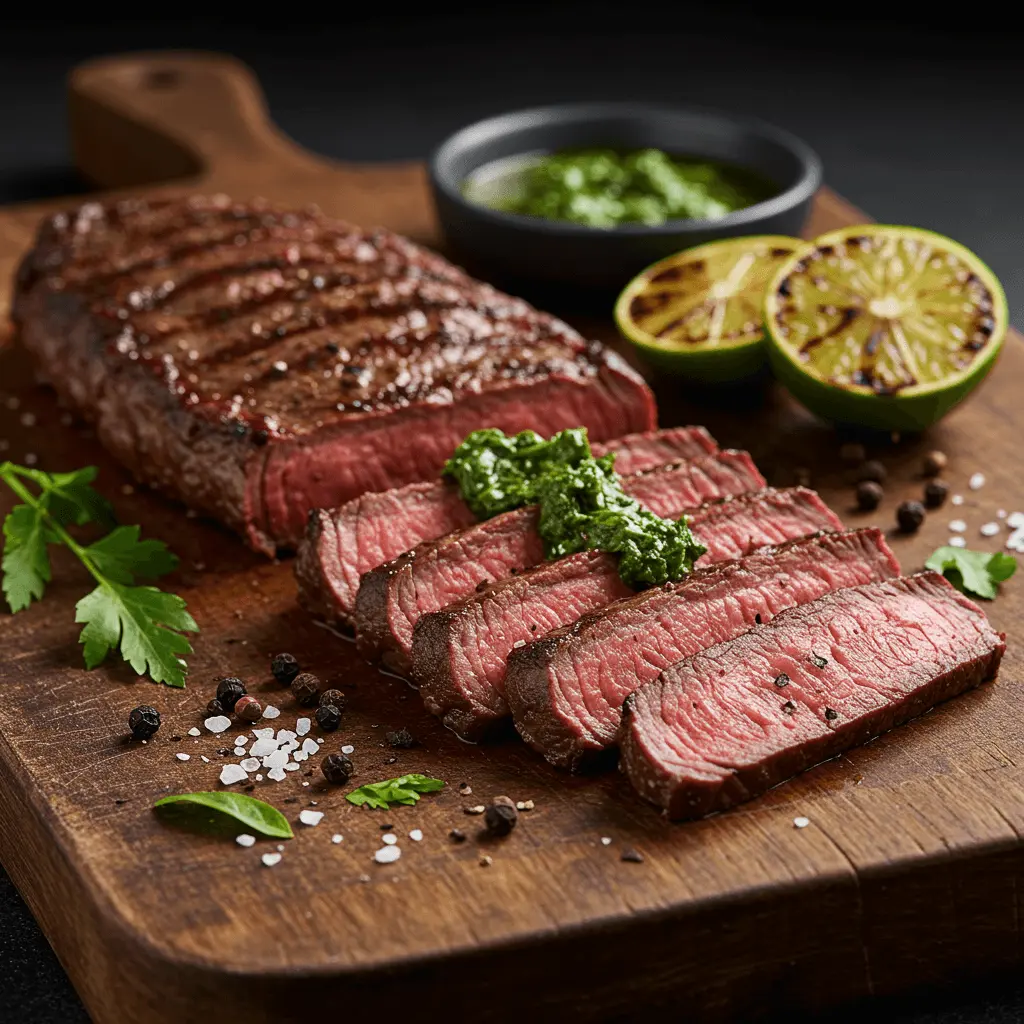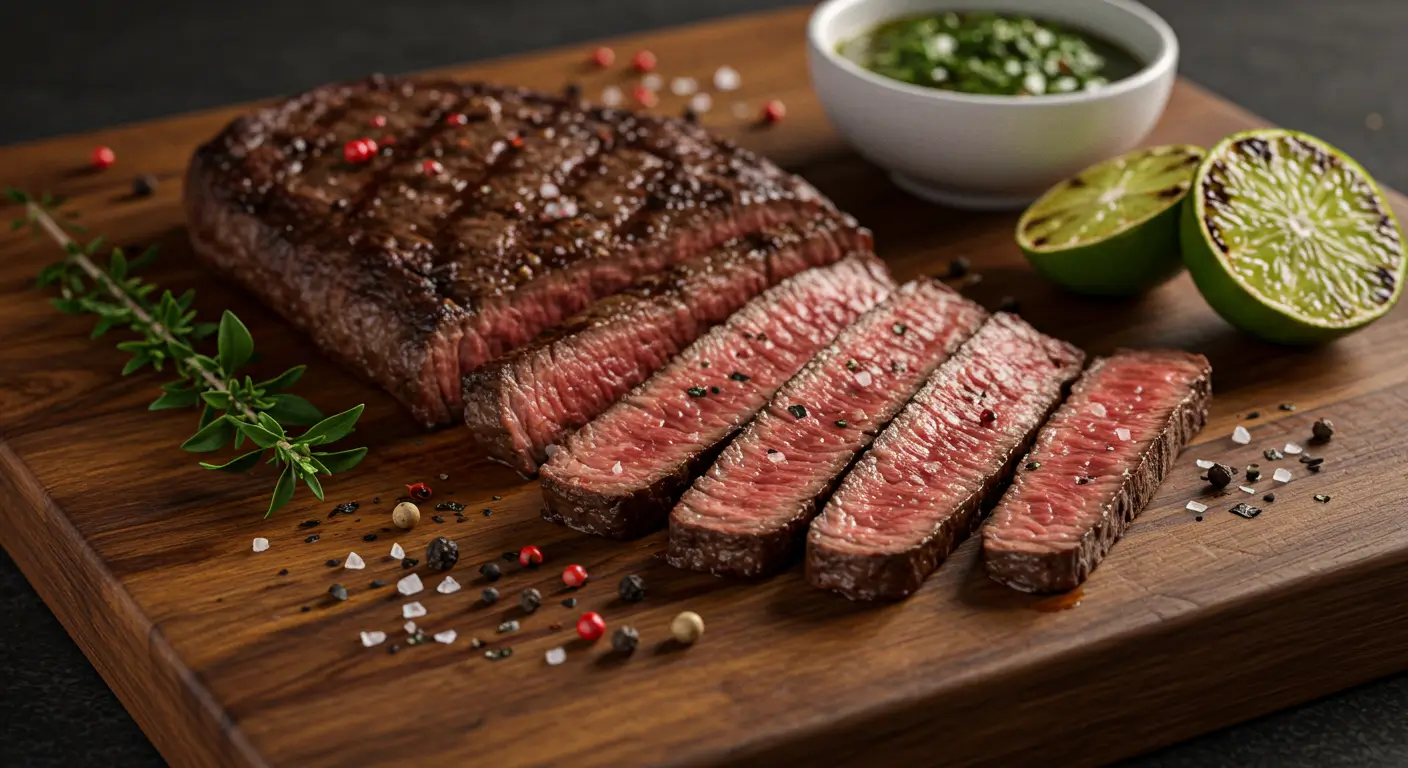Regarding beef cuts that pack a flavorful punch without breaking the bank, skirt steak deserves a special place in your culinary repertoire. This extended, thin cut has been gaining popularity beyond traditional dishes like fajitas, and for good reason. Its rich, beefy flavour profile and versatility make it a favourite among chefs and home cooks. In this comprehensive guide, we’ll dive into everything you need to know about this underappreciated cut—from what it is to how to cook it to perfection.
What is Skirt Steak?

Skirt steak is an extended, thin cut of beef from the underside of the cow near the diaphragm. This distinctive cut is immediately recognizable by its long, flat shape with visible grain across the width. What sets skirt steak apart from other cuts is its rich flavour and slightly chewy texture when properly cooked.
Anatomically speaking, skirt steak is sourced from the plate primal, located below the ribs in the abdominal cavity between the brisket and the flank. This working muscle gets plenty of exercise during the animal’s life, contributing to its robust flavour profile and explaining its relatively more challenging texture than less-worked muscles like tenderloin.
The fat marbling in skirt steak isn’t as abundant as in premium cuts like ribeye, but it has enough intramuscular fat to deliver a juicy, flavorful experience when cooked correctly. This balance of leanness and fat makes it ideal for high-heat cooking methods that can quickly render the fat while searing the exterior.
Types of Skirt Steak
Not all skirt steaks are created equal. There are two distinct types, each with their characteristics:
Inside Skirt
The inside skirt is within the body cavity and comes from the transversus abdominis muscle. This cut tends to be thicker and narrower than its counterpart. The inside skirt is more commonly available at retail locations and supermarkets. While still flavorful, it’s generally considered slightly less tender than the outside skirt and may require more attention during preparation.
Outside Skirt
The outside skirt is the animal’s diaphragm muscle and is widely regarded as the more tender and flavorful option. Restaurant chefs often prefer this cut for its superior eating quality. The outside skirt is typically broader and thinner than the inside skirt, which allows it to cook more quickly and evenly.
Due to high demand from restaurants and food service operations, outside skirts can be more challenging in typical grocery stores. Your best bet is to seek out speciality butcher shops or to request it from your meat provider precisely. The extra effort is worth it if you want the best skirt steak experience.
Cooking Methods
Skirt steak’s unique characteristics require specific cooking approaches to maximize its potential. Here are the most effective methods for preparing this flavorful cut:
Grilling: The Classic Approach
Grilling is perhaps the most popular way to cook skirt steak, and for good reason. The high, direct heat of a grill provides the perfect environment for a quick sear while preserving the meat’s juicy interior.
For best results:
- Cut the steak into manageable 5-7 inch pieces to make it easier to handle on the grill
- Pat the meat dry thoroughly with paper towels before seasoning (moisture is the enemy of a good sear)
- Season generously with salt and pepper or your preferred dry rub
- Preheat your grill to high heat (450-500°F)
- Sear each side for 3-4 minutes for medium-rare (adjust timing based on thickness)
- Allow the meat to rest for at least 10 minutes before slicing against the grain
The goal is to achieve a nice char on the outside while keeping the inside juicy and medium-rare to medium. Remember that skirt steak continues cooking during the resting period, so it’s better to err on undercooking than overcooking.
Oven Method: Precision and Convenience
When grilling isn’t an option, your oven can produce excellent results with skirt steak. The key is high heat and a short cooking time to mimic the intense heat of a grill.
Follow these steps:
- Remove the steak from the refrigerator about 45 minutes before cooking to bring it closer to room temperature
- Season with salt (and pepper if desired)
- Preheat your oven to 450°F
- Heat an oven-safe skillet over high heat until smoking
- Add a high smoke-point oil like grapeseed or avocado oil
- Sear the steak for 1-2 minutes per side
- Transfer the skillet to the oven and cook for an additional 2-3 minutes for medium-rare
- Check for an internal temperature of 120°F to 125°F
- Rest under foil for 5 minutes before slicing
This method gives you the best of both worlds: the caramelized crust from the stovetop sear and the even cooking from the oven’s ambient heat.
Sous Vide: Foolproof Perfection
For those who prize consistency and precision, sous vide cooking offers a foolproof way to prepare skirt steak to your preferred doneness. While it requires special equipment, the results can be worth the investment.
The process:
- Season the steak with salt, pepper, and any desired aromatics like garlic or herbs
- Place in sous vide bags and seal, removing as much air as possible
- Preheat your water bath to 130°F for medium-rare (adjust the temperature according to desired doneness)
- Cook for 2 hours to break down some of the more rigid fibres
- Remove from the bag and pat very dry
- Quickly sear on a screaming hot cast iron pan or grill for 1-2 minutes per side
- Rest for 2-3 minutes before slicing against the grain
The advantage of sous vide is that it’s virtually impossible to overcook the meat, allowing for precise temperature control throughout the cooking process. The final sear adds the flavorful crust that makes skirt steak so delicious.
The Art of Cutting Skirt Steak

Regardless of how you cook your skirt steak, how you cut it is arguably even more critical for the final eating experience. The single most crucial technique to remember is:
Always cut against the grain.
Skirt steak has very pronounced muscle fibres running in a clear direction. Cutting with these fibres (along the grain) will result in long strands of tough meat that are difficult to chew. Cutting perpendicular to these fibres (against the grain) shortens them, making each bite tender.
For best results:
- Allow the steak to rest after cooking (this lets the juices redistribute)
- Identify the direction of the muscle fibres
- Position your knife perpendicular to those fibres
- Slice thinly, ideally at a slight angle
- Aim for slices no thicker than ¼ inch for optimal tenderness
This simple technique can distinguish between a harsh, chewy disappointment and a delightfully tender steak experience.
Worthy Substitutes for Skirt Steak
If you can’t find skirt steak for your recipe, several other cuts can serve as reasonable alternatives:
- Flank steak: Perhaps the closest substitute, flank steak is similarly thin with a pronounced grain. It’s slightly leaner but cooks in much the same way.
- Flat iron steak: From the shoulder, this cut offers excellent marbling and tenderness with a similar rich flavour.
- Denver steak: This newer market cut comes from the shoulder and provides good marbling with a texture similar to skirt steak.
- Hanger steak: Often called the “butcher’s cut” because butchers would keep it for themselves, hanger steak offers comparable rich flavour and responds well to the same cooking methods.
While each of these cuts has its character, they can all work in recipes calling for skirt steak with minimal adjustments to cooking times.
Popular Dishes Featuring Skirt Steak
The robust flavour and texture of skirt steak make it ideal for dishes that complement its character:
- Fajitas: Perhaps the most famous application, the thin slices of grilled skirt steak are perfect for tucking into warm tortillas with sautéed peppers and onions.
- Carne Asada: This Mexican grilled meat preparation often features marinated skirt steak sliced thin for tacos or served alongside rice and beans.
- Korean Barbecue: The thin cut makes it perfect for quick grilling at the table, often after marinating in soy sauce, garlic, and Asian pear.
- Japanese Yakiniku: Similar to Korean BBQ, this Japanese grilling style showcases skirt steak’s ability to absorb flavours from marinades while cooking quickly.
- Stir-fries: When sliced very thin (easier when partially frozen), skirt steak cooks quickly in a hot wok.
- Cheesesteaks: The rich flavour makes for an upgraded version of this Philadelphia classic.
Premium Options: American Wagyu Skirt Steak

For those looking to elevate their skirt steak experience, American Wagyu versions like those from Snake River Farms offer an exceptional option. These unique cuts come from cattle that are a cross between traditional American beef breeds and Japanese Wagyu, known for their extraordinary marbling.
The American Wagyu skirt steak maintains all the flavour advantages of traditional skirt steak, adding enhanced marbling, tenderness, and a buttery quality that takes this flavorful cut to new heights. It’s particularly well-suited for applications where the steak is the star of the show rather than heavily seasoned or marinated.
This premium version is versatile enough for everything from elevated fajitas to upscale steak presentations, offering both the robust flavour of traditional skirt steak and the luxurious eating experience associated with Wagyu beef.
Frequently Asked Questions
While often confused, these cuts come from different parts of the cow. Skirt steak comes from the diaphragm muscles, while flank steak comes from the lower abdominal muscles. Skirt steak typically has a more intense beef flavour and slightly more fat marbling, while flank steak is leaner with a slightly milder flavour. They can often be used interchangeably in recipes, though cooking times may vary slightly due to differences in thickness.
Several approaches can help maximize tenderness:
1. Marinate overnight using a mixture containing acidic ingredients like citrus juice, vinegar, or buttermilk
2. Don’t skip the resting period after cooking
3. Always cut against the grain when serving
4. Consider gentle mechanical tenderization with a meat mallet (covered with plastic wrap) before cooking
5. Don’t overcook—skirt steak is best enjoyed medium-rare to medium
As a general guideline, plan for 3 to 4 ounces of cooked skirt steak per person for appetizers or when served as part of a meal with multiple dishes. 6 to 8 ounces per person for main course portions is usually appropriate. Remember that skirt steak will shrink during cooking, so purchase about 25% more than your desired serving weight.
Final Thoughts
Skirt steak offers a delicious gateway into more adventurous beef cuts beyond the standard steakhouse offerings. Its rich flavour, relatively affordable price point, and versatility make it worth mastering for any serious home cook. Whether you’re grilling it for fajitas, using it in an Asian-inspired stir fry, or simply enjoying it with a chimichurri sauce, skirt steak rewards those who take the time to understand its unique characteristics and requirements.
The keys to success are simple: cook it quickly over high heat, let it rest properly, cut it against the grain, and don’t be afraid to experiment with different marinades and seasonings that complement its robust flavour profile. Master these basics, and you’ll discover why this underappreciated cut has been a secret weapon in professional kitchens for generations.

